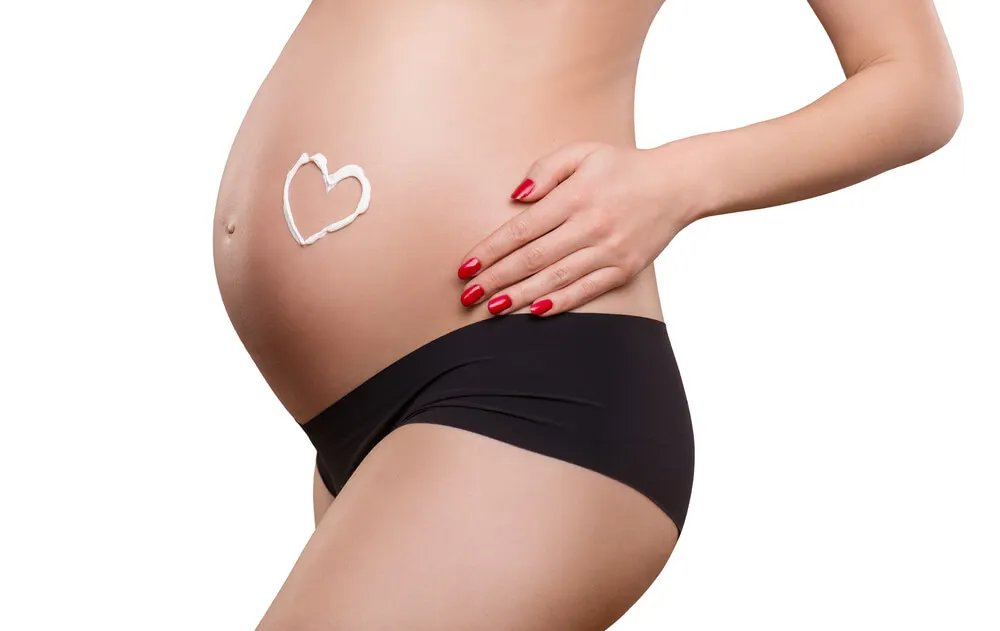Is it Possible to Use Self-tanning Lotions During Pregnancy?


Reviewed and approved by the nurse Leidy Mora Molina
During pregnancy, many questions arise about the cosmetic products that should or can be used. One of the most frequent concerns has to do with self-tanning during pregnancy since there are different opinions on this issue.
The safety of this type of product has often been questioned. Among other aspects, it’s believed that self-tanning can attenuate the formation of vitamin D induced by sunlight. It’s therefore necessary to assess the relevance of its use.
First, it must be said that there are not enough studies on the subject.
Nevertheless, the available data make it possible to establish when it is advisable to use self-tanning products during pregnancy and when there is a risk involved. This will be discussed below.
The skin and pregnancy
First of all, it’s very important to bear in mind that the skin undergoes major changes during pregnancy. Hormonal processes cause the dermis to transform and become much more sensitive to any aggression from the external environment.
You should be very careful with cosmetics, as they irritate or contribute to the appearance of blemishes. For the same reason, extreme care must be taken when exposed to the sun.
Something similar happens with self-tanning products during pregnancy. If you don’t choose the right one, or use too much, it could cause damage. It should be taken into account that some cosmetic products are not recommended when a woman is pregnant.
We think you may also enjoy reading this article: Drinking Alcohol During Pregnancy Could Change the Shape of Babies’ Brains
So, in principle, there is nothing wrong with using self-tanner during pregnancy. There’s no scientific evidence that these types of products cause any harm to the mother or the baby. In any case, it’s advisable to discuss this with your doctor.
Self-tanning products should not be confused with suntan lotions. The former provides a superficial change, giving a more orange tone to the skin. On the other hand, bronzers enhance the action of the sun, making the skin darken faster.
It should also be very clear that self-tanners do not offer sun protection by themselves unless the label clearly states that this is the case. The most important thing is to check the composition of the product and choose only those that do not generate any risk, according to the information on the label.

The composition is the key point
Until some time ago, different cosmetic products, including self-tanners and dyes, had a composition that could be very aggressive. Also, the testing of these items was not always reliable. Today, this has changed.
Most self-tanners are composed almost entirely of dihydroxyacetone. This is an element derived from sugar cane. Its action is to darken the surface of the skin when it comes into contact with proteins.
It does not penetrate deep skin layers.
These products do not stimulate the production of melanin, which is responsible for natural tanning. They only dye the outermost part of the skin. As long as it is dihydroxyacetone-based, it’s safe to use self-tanner during pregnancy.
Thanks to the above-mentioned properties, there’s no risk of the chemicals reaching the mother’s bloodstream and affecting the baby. Also, the possibility of allergic reactions is very low. In any case, it’s always necessary to make sure to read the product label to verify the composition.
Like this article? You may also like to read: Nutrition During a Multiple Pregnancy: The Main Considerations
Ingredients to avoid
The U.S. Food and Drug Administration (FDA) has indicated for 30 years that it is safe to use self-tanner during pregnancy. Ideally, however, look for products that are labeled as suitable for pregnant women.
Self-tanners often contain other elements, such as carotenoids, tocopherols, vitamin C, and amino acids. All of them are safe. However, gynecologists recommend that these products should not be used if they contain any of the following elements:
- Iodine
- Hormones
- Vitamin A and its derivatives, such as retinoic acid
Those elements could cause problems in the fetus. It takes a high amount of these components to generate a significant risk, but it’s always better to be safe.

How to apply self-tanning lotion during pregnancy
To use self-tanner during pregnancy, it’s also necessary to know how to apply it. It’s advisable not to use it before the 12th week of pregnancy. From then on, the baby’s organs have already formed and it’s safer.
Likewise, it’s advisable to use self-tanning creams or wipes. It’s not a good idea to use those that come in aerosol form, since the application can lead to the aspiration of some particles.
It should not be applied on areas with mucous membranes, such as the nose, lips, and the area around the eyes. There is no data on the risks of doing this, but caution is suggested because absorption is different in these areas.
The available information allows us to conclude that using self-tanner during pregnancy is safe.
In fact, this is a more reliable option than direct sunbathing, since both UV rays and heat can cause problems for a pregnant woman. However, to avoid risks, it’s best to only use this type of product after the first trimester.
All cited sources were thoroughly reviewed by our team to ensure their quality, reliability, currency, and validity. The bibliography of this article was considered reliable and of academic or scientific accuracy.
- Lobo, B. V., & Lobo, A. J. V. (2002). Piel y embarazo. MedUNAB, 5(14), 83-99.
- Ibáñez González, A. (2014). Efectos de los productos cosméticos en el desarrollo embrionario.
- Clémenceau, J. P. (2016). Bella esperando el bebé. Parkstone International.
This text is provided for informational purposes only and does not replace consultation with a professional. If in doubt, consult your specialist.








